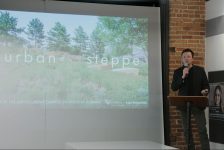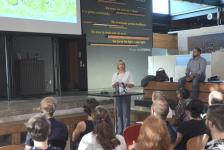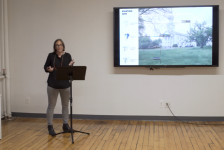When you think back on your happiest childhood memories, you probably think about playing outside. Those long summer nights camping in the backyard, catching fireflies, and climbing trees are among my most vivid adolescent memories. Not only did these experiences create happy memories, more and more studies show that they provided countless mental and physical health benefits too. Nature creates a unique sense of wonder for kids that no other environment can provide. However, in part due to the influx of technology, there has been a recent shift in how children spend their free time, often replacing outdoor time with screen time. The average American child is said to spend 4 to 7 minutes a day in unstructured play outdoors, and over 7 hours a day in front of a screen. How can we create “binge worthy” play environments that encourage outdoor play and expose children to the benefits of nature? During the Land8x8 Lightning Talks in Houston, TX, Meade Mitchell, Principal at TBG Partners’ Houston office, shared how his firm is rethinking play environments to change this downward trend and reconnect children to nature.
Recent studies have exposed a myriad of benefits that both children and adults receive by spending time outdoors, proving that there are real physical, mental, and social benefits to outdoor play. Kids who play outside are healthier, perform better academically, and have higher self-esteem and lower levels of stress. They also tend to be more creative, more social and cooperative with others, and feel better connected to nature. Direct exposure to nature is essential for healthy childhood development. Moreover, kids who play outside have a healthier adult life, resulting in a longer life span. Unfortunately, children’s exposure to nature is plummeting, and as children spend less time playing outdoors, many are missing out on these benefits.

Image: TBG Partners
Research from the National Trust shows that children are playing outside for an average of just over 4 hours each week, compared to their parents’ generation who spent an average of 8.2 hours outdoors per week. The hours spent outside playing in local parks, exploring the woods, and building forts have been mostly replaced by playing video games and watching television. We have traded green time for screen time — and it has had a serious impact on our kids’ well-being. In 2005, author Richard Louv brought the detrimental impacts of decreased childhood exposure to nature into the public’s eye with his book Last Child in the Woods, where he coined the term “nature-deficit disorder” to highlight the health costs of children’s isolation from the natural world.
As a father of four children, Mitchell has witnessed first-hand the generational change in children’s relationship with the great outdoors. As a landscape architect, Mitchell believes that he has the responsibility to change the statistics and encourage kids to play outside. To accomplish this, he needed to learn how to entice children to the outdoors and keep them entertained for longer. He needed to make the little time kids spend outside count, and endeavored to saturate play spaces with experiences that activate all senses.
As a solution, Mitchell suggests designers go beyond specifying traditional prefabricated plastic play structures and turn to nature play, which encourages active engagement with the natural environment. Mitchell asserts that even the most elaborately designed play structures of metal and plastic do not compete with immersive natural environments. Nature play experiences often include features like real wooden logs and boulders for kids to balance and climb on, sand patches or sticks for building, native plants for critter explorations, and direct access to water to watch sunbathing turtles and skip rocks. By incorporating the surrounding landscape and vegetation, nature play brings nature to children’s daily outdoor play and learning environments. Mitchell aims to combine exploration, whimsy, and education into unforgettable destinations that connect children to the natural world.
To make great nature play spaces, TBG Partners uses five areas of consideration: responsible risk taking, authentic nature (i.e. responsive to local context), productive engagement, discovery, and inclusivity. Inclusion, Mitchell notes, encompasses more than just accessibility – it also includes sensory experiences and considerations such as the play preferences of introverts and extroverts. Loose parts are often a part of nature play, inviting imagination as children combine, move, and manipulate parts. Unstructured play allows kids to interact meaningfully with their surroundings. They can think more freely, design their own activities, and approach the world in inventive ways. By providing play equipment that ranges in level of ability, children are able to attempt risks as they gain familiarity with the space, building confidence as they achieve new skills.
Believing that nature play should extend outside of playground environments, Mitchell has been taking this type of curiosity for the natural world and bringing it to the design of neighborhood parks and other green spaces. For example, Wetland Park, the signature park in the Riverstone master planned community in Sugar Land, TX, includes a mud pie kitchen, a pond with rock throwing targets, a bridge with no handrails to make it easier to watch aquatic life, logs and natural wood placed in the ponds for aquatic habitat, and a pathway of partly submerged rocks to encourage wet feet. Kids can feel the dirt, get in the water, dig in the mud, taste the cherry trees, and be immersed in nature. These types of naturalistic amenities encourage interactions and active engagement with nature, and allow children to truly feel they are a part of the environment.
The first years of a child’s experiences set the trend for the rest of their lives. As landscape architects, we have the obligation to design authentic, immersive play environments that not only benefit a child’s development, but also instill a respect and empathy for nature. By doing so, we will help inspire a conservation-minded ethos that can shape future attitudes towards stewardship, ensuring a positive future for our profession and our planet.
—
This video was filmed on June 26, 2019 in Houston, TX as part of the Land8x8 Lightning Talks sponsored by Anova Furnishings.
Published in Blog, Cover Story, Featured





![10 Billion Mouths [Video]](https://land8.com/wp-content/uploads/2018/06/michael-grove-land8x8-224x150.png)




![The Next Green Revolution [Video]](https://land8.com/wp-content/uploads/2018/01/Thomas-Rainer-Land8x8-224x150.png)
![Assuming Beauty [Video]](https://land8.com/wp-content/uploads/2019/05/walker-macy-lara-rose-land8x8-224x150.png)
